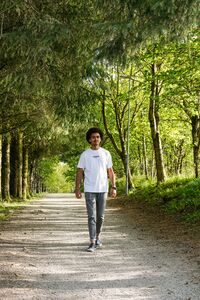Gait Definitions
Introduction[edit | edit source]
Walking is an integral part of humans' daily locomotion and an important indicator of health. It is the most common physical activity that most adults will do in their leisure time.[1]
Human gait depends on a complex interplay of major parts of the nervous, musculoskeletal and cardiorespiratory systems.
- The individual gait pattern is influenced by age, personality, mood and sociocultural factors.
- The preferred walking speed in older adults is a sensitive marker of general health and survival.
- Safe walking requires intact cognition and executive control.
- Gait disorders lead to a loss of personal freedom, falls and injuries and result in a marked reduction in the quality of life[2].
Thus, it is valuable to be able to measure and analyse human gait. In order to do so, a number of relevant terms and parameters have been defined.
Definitions[edit | edit source]
Gait - The manner or style of walking.
Gait analysis - An analysis of each component of the two phases of ambulation is an essential part of the diagnosis of various neurological disorders and the assessment of patient progress during rehabilitation and recovery from the effects of neurologic disease, a musculoskeletal injury or disease process, or amputation of a lower limb. Clinicians and researchers use various qualitative and quantitative parameters to analyse gait. A systematic review[3] in 2017 found that the most relevant parameters for gait analysis in a healthy adult population were walking velocity, cadence, and step/stride length. The authors defined relevant parameters as those that help clinicians identify gait abnormalities applicable in a rehabilitation setting.
Step length - The distance between the initial contact of one foot and the initial contact of the contralateral foot.
Stride length - The distance between the consecutive initial contacts of the same foot.
Step time - The time between the initial contact of one foot and the initial contact of the contralateral foot[4].
Stride time - The time between the consecutive initial contacts of the same foot.
Step width - The mediolateral space between the two feet[4].
Cadence - The number of steps taken per minute (steps/min).
Gait speed/velocity - Velocity is determined by one's cadence and step length, measured in units of distance over time (meters/min). Clinically, it is often calculated by measuring the time it takes to walk a specified distance, usually 6 m or less. Slower speeds correlate with an increased risk of mortality in geriatric patients.[5] Normal walking speed primarily involves the lower extremities, with the arms and trunk providing stability and balance. With faster speeds, the body depends on the upper extremities and trunk for propulsion, balance, and stability with the lower limb joints producing greater ranges of motion.[6]
Gait cycle - A repetitive pattern involving steps and strides[4] or the time from when the heel of one foot touches the ground to the time the same heel touches the ground again. The gait cycle is divided into two phases which are further divided into eight events:
- Stance Phase (60% of the gait cycle) - during which some part of the foot is in contact with the ground:
- Initial contact/heel strike
- Foot flat
- Mid-stance
- Heel off
- Toe off
- Swing Phase (40% of the gait cycle) - during which the foot is not in contact with the ground:
- Initial swing
- Mid-swing
- Late swing
The demarcation between walking and running occurs when periods of double support during the stance phase of the gait cycle (both feet are simultaneously in contact with the ground) give way to two periods of double float at the beginning and the end of the swing phase of gait (neither foot is touching the ground)[7].
References[edit | edit source]
- ↑ Schuna J, Tudor-Locke C. Step by Step: Accumulated Knowledge and Future Directions of Step-defined Ambulatory Activity. Res Exerc Epidemiol [Internet]. 2012;14(2):107–16. Available from: http://jaee.umin.jp/REE/J/14_2_107.pdf
- ↑ Pirker W, Katzenschlager R. Gait disorders in adults and the elderly. Wiener Klinische Wochenschrift. 2017 Feb 1;129(3-4):81-95.Available from:https://www.ncbi.nlm.nih.gov/pmc/articles/PMC5318488/ (last accessed 27.6.2020)
- ↑ Mary Roberts. Biomechanical parameters for gait analysis: a systematic review of healthy human gait. Physical Therapy and Rehabilitation [Internet]. 2017 Aug 16 [cited 2022 May 11];4(1):6. Available from: https://www.hoajonline.com/phystherrehabil/2055-2386/4/6
- ↑ 4.0 4.1 4.2 Loudon J, et al. The clinical orthopedic assessment guide. 2nd ed. Kansas: Human Kinetics, 2008. p.395-408.
- ↑ Medical dictionary Gait speed Available from: https://medical-dictionary.thefreedictionary.com/gait+speed (last accessed 28.6.2020)
- ↑ Shultz SJ et al. Examination of musculoskeletal injuries. 2nd ed, North Carolina: Human Kinetics, 2005. p55-60.
- ↑ The biomechanics of running Tom F. Novacheck Motion Analysis Laboratory, Gillette Children’s Specialty Healthcare, Uni6ersity of Minnesota, 200 E. Uni6ersity A6e., St. Paul, MN 55101, USA Received 25 August 1997; accepted 22 September 1997 Available from:








